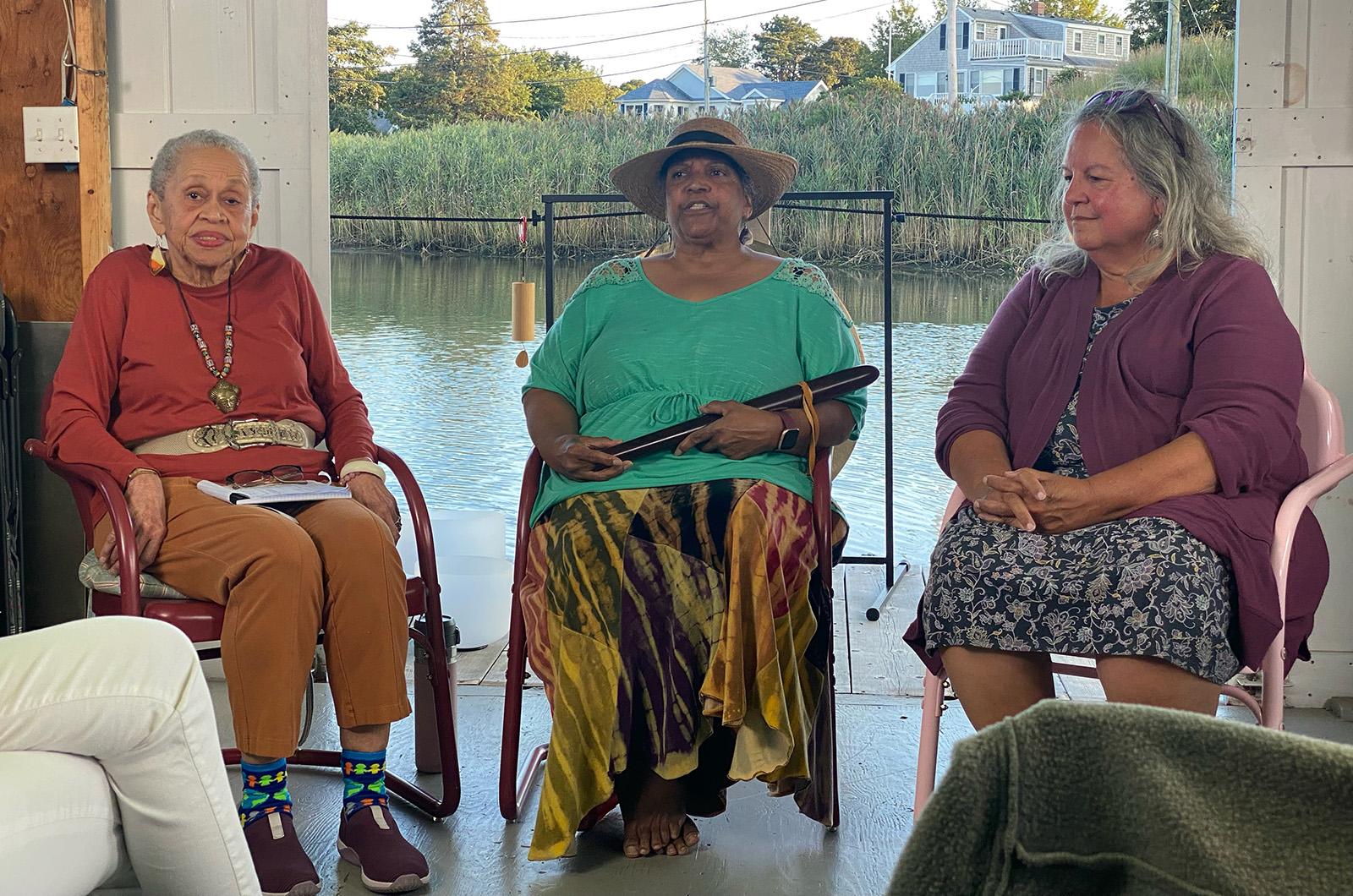At the end of a gangplank in Vineyard Haven Harbor bobs the Lagoon Pond Floating Gallery, a blue box haven for environmental artistic expression.
On Friday, the gallery became a venue for conversation between two groundbreaking women scientists — one African American and the other Wampanoag — about the importance of empowering students of color in the sciences and arts, and considering Indigenous science alongside more mainstream Western scientific methodologies.
During the event, Rudean Leinaeng and Carole Vandal discussed their careers in science and their warnings about the future in the face of a warming climate and environmental degradation.
The gallery, owned by Marion Wilson, often displays art focused on the environment and endeavors to preserve the lagoon coastline by creating a space for conversation about scientific and artistic interventions. Friday’s discussion was one among a series of summer of events connecting art and the environment.
“The diversity of the Island is just amazing,” Ms. Wilson said. “This summer I’ve opened my doors to have conversations about the issues and with the people who inspire me.”
Ms. Leinaeng’s son, filmmaker Thomas Allen Harris Jr., introduced the discussion. His latest film, My Mom, The Scientist, tells the story of his mother’s life and career as a chemist. Putting the finishing touches on his project, Mr. Harris Jr. organized and filmed Friday’s event to include it as a scene in his film.
“The film looks at the ways in which people of color, African Americans and Hispanics and Indigenous Americans, have been kept out of science fields in many ways,” he said.
In line with the film’s message, Mr. Harris moderated the conversation with a focus on the ways in which both women not only broke barriers to succeed in the sciences but also helped others as educators.
Ms. Vandal’s connection to the Island spans millennia, and her introduction to the sciences began with her grandfather, the Wampanoag’s medicine man during her childhood. As an adult, Ms. Vandal was recruited to join the then-named American Indians into Medicine program at the University of Minnesota, where she studied until she was assaulted by a police officer and left school.
After taking time off, starting her family and earning her two-year fisheries degree, Ms. Vandal received her teaching license from Bemidji State University in Bemidji, Minn. She then taught high school students through Upward Bound, 50 per cent of whom were Native and most of whom were first generation graduates.
“Against all odds, we got into science,” Ms. Vandal said. “It wasn’t easy. We had heard enough about the ‘dumb Indian,’ the ‘drunken Indian,’ and it beat us down — for a moment — but we rose up.”
Having had a teacher who believed in her potential as a child, Ms. Vandal said she also wanted to be a teacher who empowered her students through education.
“Through our learning, no matter what they’ve done to us in the past, they can’t take that knowledge away from us,” she said.
Ms. Leinaeng, who has visited the Island every summer for decades, has also spent her career helping students of color advance in the fields of science and art. After receiving her undergraduate and graduate degrees in chemistry, Ms. Leinaeng taught at Bronx Community College for 30 years, encouraging generations of students, many of whom were students of color, to pursue research opportunities and degrees in science.
In addition to her work as an educator, Ms. Leinaeng has been an activist, participating in the struggle for women’s rights and racial equality. She moved to Tanzania in the 1970s, where she participated in the anti-apartheid struggle and taught chemistry and physics at a girls school.
Today, Ms. Leinaeng has shifted her focus once more. She is now an author, penning novels that draw from her own family’s history, as well as ancestral scientific practices. Ms. Leinaeng has written her latest work in honor of spiritual healers.
“There’s no way to know all the accomplishments and contributions people of color have made in the healing arts,” she said. “Powerful women healers, enslaved and free, wove a patchwork of herbal knowledge from the ancestral lands.... When you have a connection to the earth, plants will teach you their wisdom.”
This was a sentiment echoed by audience member Robin Wall Kimmerer, whose bestselling book Braiding Sweetgrass: Indigenous Wisdom, Scientific Knowledge, and the Teachings of Plants examines the role of Indigenous knowledge as an additional or alternative approach to Western scientific methodologies.
Ms. Kimmerer joined Ms. Leinaeng and Ms. Vandal to continue the discussion about the evolving relationship between humans and the land and the importance of considering a range of scientific methodologies.
“I am sitting in awe of your storytelling and your fortitude,” Ms. Kimmerer said to the panelists. “Like you, I have navigated the space of becoming a Native scientist in hostile environments... There are many ways to understand the living world and our relationship to it and our relationships to one another. Western science alone is not doing it, we need to bring together all our stories in a holism that Western science doesn’t really permit.”
Ms. Leinaeng echoed Ms. Kimmerer’s call to consider alternative and ancestral practices.
“Especially now, in the time of global warming, it is especially important to look at Indigenous sciences,” Ms. Leinaeng said. “They’ve been warning us about this for a long time.”




Comments (1)
Comments
Comment policy »